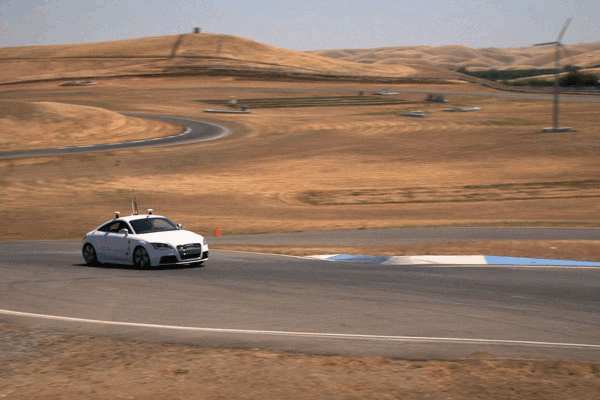| Stanford's Robotic Racecar Learns From Humans |
| Written by Alex Armstrong | |||
| Tuesday, 21 August 2012 | |||
|
Professional racing drivers are helping robot engineers to improve the algorithms used by Shelley, Stanford's self-driving racing car. While Google's self-driving family saloon is focusing on the everyday hazards of the daily commute to work, Stanford's Audi TTS Shelley is taking to the race track for high speed tests of its software.
Shelley, the product of collaboration between Stanford's Dynamic Design Lab and the Volkswagen Electronics Research Lab can be seen in action at the Thunderhill Raceway in California in this video. What you don't notice, as the engine roars and the tires squeal is that there isn't a human on board. This performance, that got the car around the 3-mile course in less than 2.5 minutes with a top speed on the straights of 120 mph, a time that rivals those posted by professional drivers, was all done by on-board algorithmic control.
Why concentrate on speedway driving when the long-term aim of the project is for autonomous vehicles that will takeover the day-to-day driving chores of getting from A to B on normal, traffic-laden roads in safety? According to Chris Gerdes who leads the Stanford team pushing the car to its limits is the best way to learn what type of stress a car is under in a crisis, and what it takes to get the car straightened out. For example, the math involved in getting a spinning wheel to grip the pavement is very similar to recovering from a slide on a patch of ice. The tests at Thunderhill revealed that the route charted around the course by Shelley's algorithms were close to the path selected by a professional drive. Even so the best human drivers are still faster around the track, if just by a few seconds. According to Gerdes this is because while Shelley computes the fastest line around a course and executes the exact corrections required to stick to it, a person relies more on feel and intuition and may, for example, allow the car to swing too wide in one turn if he knows it sets him up better for the next. In order to discover more about human performance the team has enlisted the help of two professional drivers arranging for the to wear a suite of biological sensors as they raced last weekend at the Rolex Monterey Motorsports Reunion event at the Laguna Seca Raceway. Among other things, the sensors recorded the drivers' body temperature and heart rate and, to determine which driving maneuvers require the most concentration and brainpower, scalp electrodes registered brain activity during the race. This biological data will be paired with mechanical performance data from the car – a 1966 Ford GT40, the only American-built automobile to finish first overall at the 24 Hours of Le Mans race – which Stanford has kitted out with feedback sensors similar to those on Shelley. Gerdes explained: "We need to know what the best drivers do that makes them so successful. If we can pair that with the vehicle dynamics data, we can better use the car's capabilities." So just as the best driver seem to be in harmony with their vehicles, this research is look to ensure that driving algorithms are equally responsive.
Related ArticlesGoogle Self-Driving Car For Daily Commute Sebastian Thrun on Google's driverless car Driverless Cars - More Than Just Google Driverless Cars Become Legal - The Implications Robot cars - provably uncrashable? Self-Driving Cars For Stock Car Racing?
Comments
or email your comment to: comments@i-programmer.info
To be informed about new articles on I Programmer, install the I Programmer Toolbar, subscribe to the RSS feed, follow us on, Twitter, Facebook, Google+ or Linkedin, or sign up for our weekly newsletter.
|
|||
| Last Updated ( Tuesday, 21 August 2012 ) |


